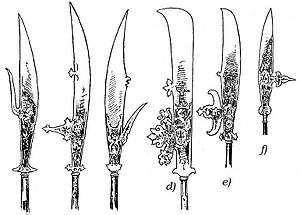Glaive

A glaive (or glave) is a European polearm weapon, consisting of a single-edged blade on the end of a pole. It is similar to the Japanese naginata, the Chinese guandao, Russian sovnya and Siberian palma.
Overview
Typically, the blade was around 45cm (18 inches) long, on the end of a pole 2 m (6 or 7 feet) long, and the blade was affixed in a socket-shaft configuration similar to an axe head, rather than having a tang like a sword or naginata. Occasionally glaive blades were created with a small hook on the reverse side to better catch riders. Such blades are called glaive-guisarmes.
According to the 1599 treatise Paradoxes of Defence by the English gentleman George Silver, the glaive is used in the same general manner as the quarterstaff, half pike, bill, halberd, voulge, or partisan. Silver rates this class of polearms above all other individual hand-to-hand combat weapons.

The Maciejowski Bible (Morgan Bible) depicts an example of a two-handed glaive used on horseback.
The contemporary term for this weapon may have been faussart, which was used for a variety of single-edged weapons seen as related to the scythe (along with terms such as falchion or falcata derived from falx, the Latin term for "scythe").
Other uses of the word
The word "glaive" has historically been given to several very different types of weapons.
- The word "glaive" originated from French. Almost all etymologists derive it from either the Latin (gladius) or Celtic (*cladivos, cf. claymore) word for sword. Nevertheless, all the earliest attestations in both French and English refer to spears.[1] It is attested in this meaning in English roughly from the 14th century to the 16th.[2]
- In the 15th century, it acquired the meaning described above.[3]
- Around the same time it also began being used as a poetic word for sword (this is the main use of the word in Modern French).[4]
- The term "glaive" is used in modern fantasy fiction, films and video games to refer to various thrown weapons, similar to the chakram or hunga munga, which can mystically return to the thrower (as in popular myths surrounding the boomerang). These objects are fictional, and are not in any way related to the historical glaive.
- Champagne saucers are often colloquially termed glaives. The name refers to the traditional wine glass being 'glaived', resulting in a shorter than normal glass.
References
- ↑ OED s.v. Glaive: "Hatz-Darm. regard OF. glaive as an adapted form of L. gladius (through the stages gladie, glaie, glavie). Ascoli supposes it to represent a Celtic *cladivo- (OIr. claideb sword, Gael. claidheamh). Neither view, however, accounts for the earliest meaning of the word in OF., which is also that of MHG. glavîe, glævîn, MDu. glavie, glaye, Sw. glaven."
- ↑ OED s.v., section 1, lists examples in this meaning from 1297–1592.
- ↑ OED s.v., section 2, lists examples in this meaning from ca. 1450–1678.
- ↑ OED s.v., section 3, lists examples in this meaning from ca. 1470–1887.